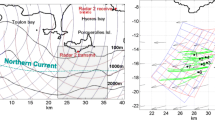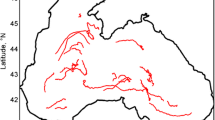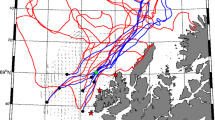Abstract
The ocean drift current consists of a (local) pure drift current generated by the interaction of wind and waves at the sea surface, to which the surface geostrophic current is added vectorially. We present (a) a similarity solution for the wave boundary layer (which has been validated through the prediction of the 10-m drag law), from which the component of pure drift current along the direction of the wind (and hence the speed factor) can be evaluated from the 10-m wind speed and the peak wave period, and (b) a similarity solution for the Ekman layers of the two fluids, which shows that under steady-state neutral conditions the pure drift current lies along the direction of the geostrophic wind, and has a magnitude 0.034 that of the geostrophic wind speed. The co-existence of these two similarity solutions indicates that the frictional properties of the coupled air-sea system are easily evaluated functions of the 10-m wind speed and the peak wave period, and also leads to a simple expression for the angle of deflection of the pure drift current to the 10 m wind. The analysis provides a dynamical model for global ocean drift on monthly and annual time scales for which the steady-state neutral model is a good approximation. In particular, the theoretical results appear to be able to successfully predict the mean surface drift measured by HF Radar, which at present is the best technique for studying the near surface velocity profile.


Similar content being viewed by others
Notes
The exact expressions for the components of mean velocity in the Ekman layer are, <u3> = u2 exp(−z′)sin(z′)/(z′) and <v 3> = v 2 [1 − exp(−z′) cos(z′)]/(z′), where z′ = z 3/z E. For z′ → 0, <u3> → u2 and <v3> → v2, and over the complete extent of the Ekman layer (z′ → ∞), the components of Ekman transport (U E = <u 3>z 3) are UE = 0, and from (37), V E = − (R − 1)w* z E/\( K_{\text{I}}^{ 1/ 2} \), which, on eliminating z E yields the classical expression, V E = −w 2* /f.
The velocity profiles in the Ekman layer are shown in Chereskin (1995) and also discussed in Jenkins and Bye (2006).
Abbreviations
- u(z):
-
Air velocity at height z
- u(−z):
-
Water velocity at depth − z
- oz :
-
Vertically upward axis, undisturbed sea surface, z = 0
- ρ 1 :
-
Density of air
- ρ 2 :
-
Density of water, ε = (ρ 1/ρ 2)1/2
- τ s :
-
Surface shear stress
- u * :
-
(u*, 0) friction velocity in air
- w * :
-
(w*, 0) friction velocity in water
- u L :
-
Wave induced velocity in air (the spectrally weighted phase velocity)
- ε u L :
-
Wave induced velocity in water (the surface Stokes velocity), which occur at |z| = z R
- u o :
-
Reference velocity for the air-sea boundary layer
- u 1 :
-
u(z B) surface wind
- u 2 :
-
u(−z B) surface current
- z B :
-
gT 2/8π 2
- T :
-
Peak wave period
- g :
-
Acceleration of gravity
- u S :
-
Surface drift velocity
- u10 :
-
10 m wind speed, z 10 = 10 m
- κ :
-
von Karman’s constant
- K :
-
K(|z|) drag coefficient at |z| in both fluids
- K I :
-
¼ K(z B) inertial drag coefficient
- R :
-
Frictional parameter in the wave boundary layer, see Fig. 1
- k 1 :
-
1/2z R spectral high wave number cut-off
- k o :
-
1/2z B wave number of the peak wave
- a o :
-
Amplitude of the breaking wave
- Q 1 and Q 2 :
-
Ekman layer frictional coefficients in air and water respectively
- υ 1 and υ 2 :
-
Dynamic eddy viscosities in air and water respectively
- f > 0:
-
Coriolis parameter
- G :
-
Coefficient of non-dimensional eddy viscosity in the Ekman layers
- u g :
-
Surface geostrophic wind
- α = ½/(R − 1):
-
Non-dimensional frictional parameter in the Ekman layers
- K o :
-
Geostrophic drag coefficient
- γ :
-
Angle of turning of the surface geostrophic wind to the left hand side of the surface shear stress in the northern hemisphere
- z s :
-
Roughness length for the velocity profiles at the sea surface
- u d :
-
Mean drift current in the surface drift layer
- z HF :
-
Depth sampled by the HF Radar measurements
- z 3 :
-
Penetration depth of the HF Radar measurements into the Ekman layer
- z E :
-
Ekman depth
- φ = z HF/z B :
-
The proportion of the wave boundary layer sampled by the HF Radar measurements
- u HF = (uHF, v HF):
-
HF Radar mean drift current
- γ HF :
-
Angle of turning of the HF Radar mean drift current to the left hand side of the surface shear stress
- [u HF ] :
-
Total HF Radar mean drift current
- [γHF]:
-
Angle of turning of the total HF Radar mean drift current to the left hand side of the surface shear stress
References
Andreas EL, Mahrt L, Vickers D (2012) A new drag relation for aerodynamically rough flow over the ocean. J Atmos Sci 69:2520–2537. doi:10.1175/JAS-D-11-0312.1
Ardhuin F, Marie L, Rascle N, Forget P, Roland A (2009) Observation and estimation of Lagrangian, Stokes and Eulerian currents induced by wind and waves at the sea surface. J Phys Oceanogr 39:2820–2838. doi:10.1175/2009JPO4169.1
Bye JAT (1965) Wind-driven circulation in unstratified lakes. Limnol Oceanogr 10:451–458
Bye JAT (1987) Observations of drift velocity, wind and temperature profiles on the San Diego Model Yacht Pond (1965–1967). Cruise Rep. 12 Flinders Institute for Atmospheric and Marine Sciences, The Flinders University of South Australia
Bye JAT (1988) The coupling of wave drift and wind velocity profiles. J Mar Res 46:457–472
Bye JAT (1995) Inertial coupling of fluids with large density contrast. Phys Lett A 202:222–224
Bye JAT (2002) Inertially coupled Ekman layers. Dyn Atmos Oceans 35:27–39
Bye JAT (2012) Southern Ocean surface drift: old observations and new theories. Weather 67:187–191
Bye JAT, Wolff J-O (2002) Prediction of the drag-law for air-sea momentum exchange. Ocean Dyn 54:577–580
Bye JAT, Jenkins AD (2006) Drag coefficient reduction at very high wind speeds. J Geophys Res 111:C03024. doi:10.1029/2005JC003114
Bye JAT, Wolff J-O (2008) Charnock dynamics: a model for the velocity structure in the wave boundary layer of the air-sea interface. Ocean Dyn 58:31–42
Bye JAT, Ghantous M, Wolff J-O (2010) On the variability of the Charnock constant and the functional dependence of the drag coefficient on wind speed. Ocean Dyn 60:851–860
Bye JAT, Wolff J-O, Lettmann KA (2014) On the variability of the Charnock constant and the functional dependence of the drag coefficient on wind speed: part II—observations. Ocean Dyn 64:969–974. doi:10.1007/s10236-014-0735-4
Chereskin TK (1995) Direct evidence of an Ekman balance in the California current. J Geophys Res 100:18261–18269
D’Asaro EA, Thomson J, Shcherbina AY, Harcourt RR, Cronin MF, Hemer MA, Fox-Kemper B (2014) Quantifying upper ocean turbulence driven by surface waves. Geophys Res Lett 41:1–6. doi:10.1002/2013GL058193
Ekman VW (1905) On the influence of the Earth’s rotation on ocean-currents. Arkiv for Matematik Astronomi och Fysik 2(11):1–52
Foreman RJ, Emeis S (2010) Revisiting the definition of the drag coefficient in the marine atmospheric boundary layer. J Phys Oceanogr 40:2325–2332
Friehe CA, Smith JA, Rieder KF, Huang NE, Giovanangeli JP, Geernaert GL (2001) Chapter 12 Wind, stress and wave directions 232–241. In: Wind stress over the Ocean. Jones ISF, Toba Y (eds) Cambridge University Press, Cambridge
Garratt JR (1992) The atmospheric boundary layer. Cambridge Univ. Press, Cambridge, p 307
Geernaert GL (1988) Measurements of the angle between the wind vector and wind stress vector in the surface layer over the North Sea. J Geophys Res 93:8215–8220
Hughes P (1956) A determination of the relation between wind and sea-surface drift. Q J R Meteorol Soc 82:494–502
Ide Y, Yoshikawa Y (2015) Effects of diurnal cycle of surface heat flux on wind-driven flow. J Oceanogr. doi:10.1007/s10872-015-0328-y (online 04 November 2015)
Jenkins AD, Bye JAT (2006) Some aspects of the work of V.W. Ekman. Polar Rec 42:15–22. doi:10.1017/S00322347405004845
Lumpkin R, Pazos M (2007) Measuring surface currents with Surface Velocity Program drifters: the instrument, its data, and some recent results, Chap 2. In: Griffa A, Kirwan AD, Mariano AJ, Ozgokmen T, Rossby T (eds) Lagrangian analysis and prediction of coastal and ocean dynamics (LAPCOD), Cambridge University Press, Cambridge
Maximenko N, Niiler P, Centurioni L, Rio M-H, Melnichenko O, Centurioni L, Chambers D, Zlotnicki V, Galperin B (2009) Mean dynamic topography of the ocean derived from satellite and drifting buoy data using three different techniques. J Atmos Ocean Technol 26:1910–1919
McWilliams JC, Huckle E, Liang J-H, Sullivan PP (2012) The wavy Ekman layer: Langmuir circulations, breaking waves, and reynolds stress. J Phys Oceanogr 42:1793–1816
Pond S, Pickard GL (1983) Introductory dynamical oceanography, 2nd edn. Pergamon Press, Oxford, p 329
Rieder KF, Smith JA, Weller RA (1994) Observed directional characteristics of the wind, wind stress and surface waves on the open ocean. J Geophys Res 99:22596–22598
Samuels WB, Huang NE (1982) An oilspill trajectory analysis model with a variable wind deflection angle. Ocean Eng 9:347–360
Thorpe SA (2004) Langmuir circulation. Ann Rev Fluid Mech 36:55–79. doi:10.1146/annurev.fluid.36.052203.071431
Toba Y (1973) Local balance in the air-sea boundary process III. On the spectrum of wind waves. J Oceanogr Soc Jpn 29:209–220
Yelland M, Taylor PK (1996) Wind stress measurements from the open ocean. J Phys Oceanogr 26:541–558
Yoshikawa Y, Masuda A (2009) Seasonal variations in the speed factor and deflection angle of the wind-driven surface flow in the Tsushima Strait. J Geophys Res 114:C12022. doi:10.1029/2009JC005632
Zhang W, Ebuchi N, Fukamachi Y, Yoshikawa Y (2015) Estimation of wind drift current in the Soya Strait. J Oceanogr. doi:10.1007/s10872-015-0333-1 (online 23 November 2015)
Acknowledgements
JATB gratefully acknowledges the award of a Fellowship at the Hanse-Wissenschaftskolleg, Delmenhorst, Germany in the first half of 2013 during which this study was carried out in the Institute for Chemistry and Biology of the Sea (ICBM), University of Oldenburg. Informed comments by Professor Yutaka Yoshikawa and two other Reviewers are also especially acknowledged.
Author information
Authors and Affiliations
Corresponding author
Rights and permissions
About this article
Cite this article
Bye, J.A.T., Wolff, JO. & Lettmann, K.A. A note on ocean surface drift with application to surface velocities measured with HF Radar. J Oceanogr 73, 491–502 (2017). https://doi.org/10.1007/s10872-017-0417-1
Received:
Revised:
Accepted:
Published:
Issue Date:
DOI: https://doi.org/10.1007/s10872-017-0417-1





